The Yankee Chatter is the periodic newsletter of the Yankee Chapter of the Antique Motorcycle Club of America. This page contains a collection of articles excerpted from the Chatter since the summer of 2019.
I just rode by the [Northford Volunteer Fire Department] station house again, and the sign posted out front was advertising the next fried dough event, and it’s on Friday July 12th. Strike two – NO FRIED DOUGH FOR YOU! The reason why is that I’ll be flying out to Columbus Ohio to help out Mark Hunnibell’s epic Across America By Motorcycle event, which is a celebration of the 100th anniversary of CK Shepherd’s cross country trip on a then new 1919 Henderson Four that started at Coney Island, New York and ended in San Francisco. CK wrote a book about it that became Mark’s guide – he’s attempting to retrace the route as accurately as possible. Mark is embarking on this on a 1919 Henderson Four that he restored, and was given to him as a basket case by his father many years ago.
My contribution is to be the service van driver between Ohio and Colorado from July 11th to the 19th, so therefore, no fried dough! Debbie Faucher, Dana’s wife, will be providing service van support for the Colorado to San Francisco leg. Mark is a current AMCA member and he’s still on our roster, having lived in Massachusetts for a time. I’m looking forward to what promises to be a very interesting adventure,
and I plan to have an article about the experience in the Fall edition of the Chatter. You can see more at Mark’s site, acrossamericabymotorcycle.com. There you can get the backstories on Mark, his 1919 Henderson, and of course CK Shepherd’s book upon which Mark’s dream adventure is based.
…
Greg

…
The PDF of this article is also available here.
In the previous edition of the Chatter, I mentioned that I was soon to head out to Columbus, Ohio where I was to join Mark Hunnibell as he progressed on his effort to celebrate the 100th anniversary of CK Shepherd’s cross country trip on a then new 1919 Henderson Four that started at Coney Island, New York and ended in San Francisco. Mark had discovered Shepherd’s book documenting the trip, and as he was the owner of 1919 Henderson Four himself, decided to embark on wholesale adventure that included not only the ride, but a companion book annotated from his experience of researching the original route, a website dedicated to his endeavors to make the ride a hundred years later.
This all came about when Dan Margolien sent me a request to contact other members of the AMCA (Mark is member of the AMCA, and was a Yankee member at one time) regarding helping Mark on his adventure. The driver of his support vehicle opted out, due to a potential impact to his business. Having the time available, I consulted with my wife Terry, and she gave her blessing as long as there was no financial impact to us, which there wasn’t as Mark would be covering travel and accommodation expenses.
Upon my arrival in Columbus, which was the nearest airport to Mark’s home and base of operations in Yellow Springs, Mark picked me up, and so began a quite interesting journey. After a few minutes of introduction, which included a quick question of whether or not I received Mark’s last email to me, which had been sent while I was in mid air, probably somewhere over Pennsylvania. At that time, and upon opening the email later, the need for me, and probably Dana’s wife, Debbie Faucer’s services to drive the support vehicle had essentially evaporated, as Willie, Mark’s driver for the first third of the trip from Coney Island to Yellow Springs had agreed to stay on. During that ride to Yellow Springs, I came to realize that I had no real purpose other than to provide company for Willie for the trek from Yellow Springs to Colorado where I would take my flight home from Denver.
Upon my arrival in Yellow Springs, I met Loring Hill, Mark’s twenty-one year old mechanic and companion (on his BMW RT). I was also introduced to Mark’s Henderson, as Loring was completing his nightly service routine to help insure that the centurion would complete the journey successfully. Loring’s father, Mark Hill, who through his 4 Motion Cycles operation helps a number of ACMA members and others prep and maintain their vintage machines to participate in the biannual Cannonball and other vintage contests of long distance rides.
At this time, I also met Willie, who had just recently met Mark (both residing in Yellow Springs) and had volunteered to initially take over for Loring’s dad for the first third of the journey. Over the next few days riding in the support truck (and towed trailer) with Willie, we got to know each other a bit, fulfilling my new duties as providing him with companionship along the way.
Over the next few hours, before settling in for the night, I learned of two mechanical incidents encountered prior to arriving in Ohio. Mark had apparently run over a good size screw on the rear tire, resulting in a flat. Luckily, Mark had a spare set of rims and tires, though the rims were unpainted and mounted with knobbies for the excursion up Pike’s Peak when in Colorado. Additionally, Mark also had a bit of bad luck hitting a rock, which broke the foot clutch pedal, which was remedied by finding a local welder who put the pedal back together.
After Loring completed the maintenance, he rolled the Henderson into the trailer, along with his BMW and locked it up for the night, ready for the early morning departure.
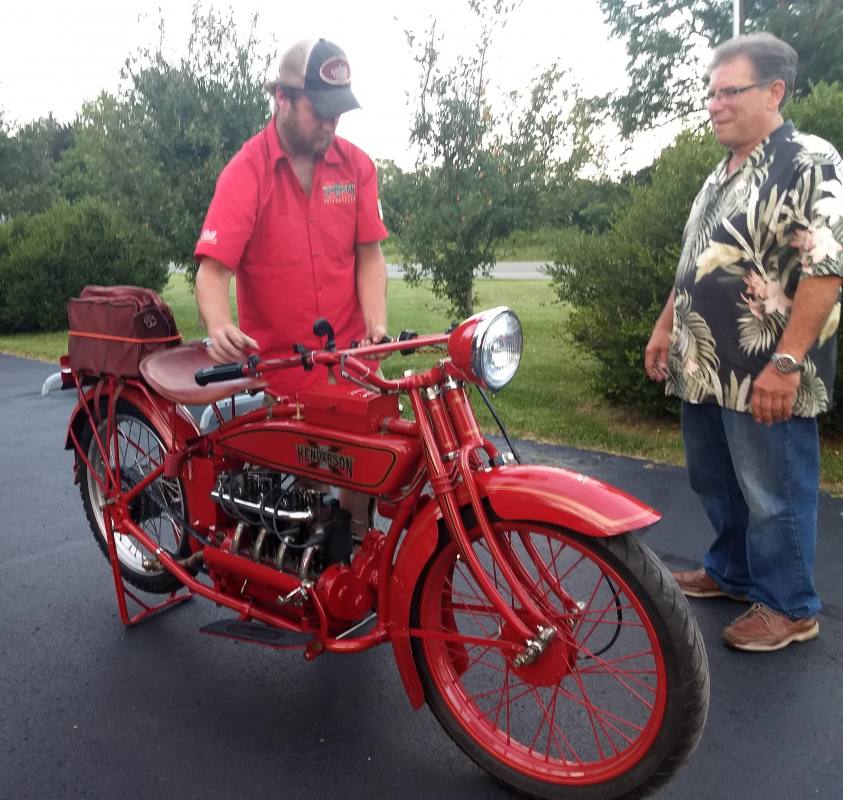 Loring Hill (left) and Willie Fernandez (right) in Yellow Springs – note the saddlebags up and out of the way
Loring Hill (left) and Willie Fernandez (right) in Yellow Springs – note the saddlebags up and out of the way
for servicing, and the shiny rear wheel that replaced the painted rim with the flat.
The next morning, Loring and Mark unpacked both bikes, fired up the Henderson, which by the way started mostly with a single kick. Willie and I hopped into the truck and began following them, destined for Indianapolis, Indiana, home of the fabled Indy 500. Mark had planned a stop on the way to meet with some former friends for a photo shoot. Most evenings, Mark had arrangements to meet with radio station hosts and other reporters set up by his publicist to help promote the trip, and the companion books.
After that stop, we proceeded to Indianapolis, where Willie and I helped Loring set up for the nightly maintenance routine before we checked into the hotel. The maintenance routine was fairly thorough – drain the oil, check the oil for any evidence of issues, fill it back up, check the valve tappets (an easy task as these were exposed on the top of the cylinder heads) and adjust, if needed (mostly minor tweaks), clean and degrease the engine, lubricate the tappets, and then proceed to checking all the nuts, bolts and screws on the entire bike to ensure they were tight for the next morning. The bike was then wiped down so that it looked good for the next day’s journey as well.
I continued to be a bit vexed as to why I was still there, as accommodations and meals on the road had to add to Mark’s overall expenses. From my perspective, I intended to stay on as long as I could, hopefully making it to Colorado a few days of later to fly home.
The next day we headed to our next destination, Hannibal, Missouri, well known for one of America’s preeminent authors , Mark Twain. Along the way, the hundred year old bike lost its exhaust baffle plate mechanism (an option apparently used to keep the bike quiet running through town). We pulled into a parking lot where Loring immediately went to work to close the two inch by four inch hole in the exhaust by cutting up an aluminum can and securing it with hose clamps and header wrap (and more hose clamps). Problem solved (for the immediate at least), we headed out down the road. After an hour or two, Willie and I observed Mark pulling over again, as the fix exhausted itself (ok – corny pun time!) by actually melting the aluminum can and the header wrap an partially melting Mark’s right boot. Loring again went to work after first visiting a local auto parts store for a more robust piece of stainless steel to hopefully secure a longer lasting fix.
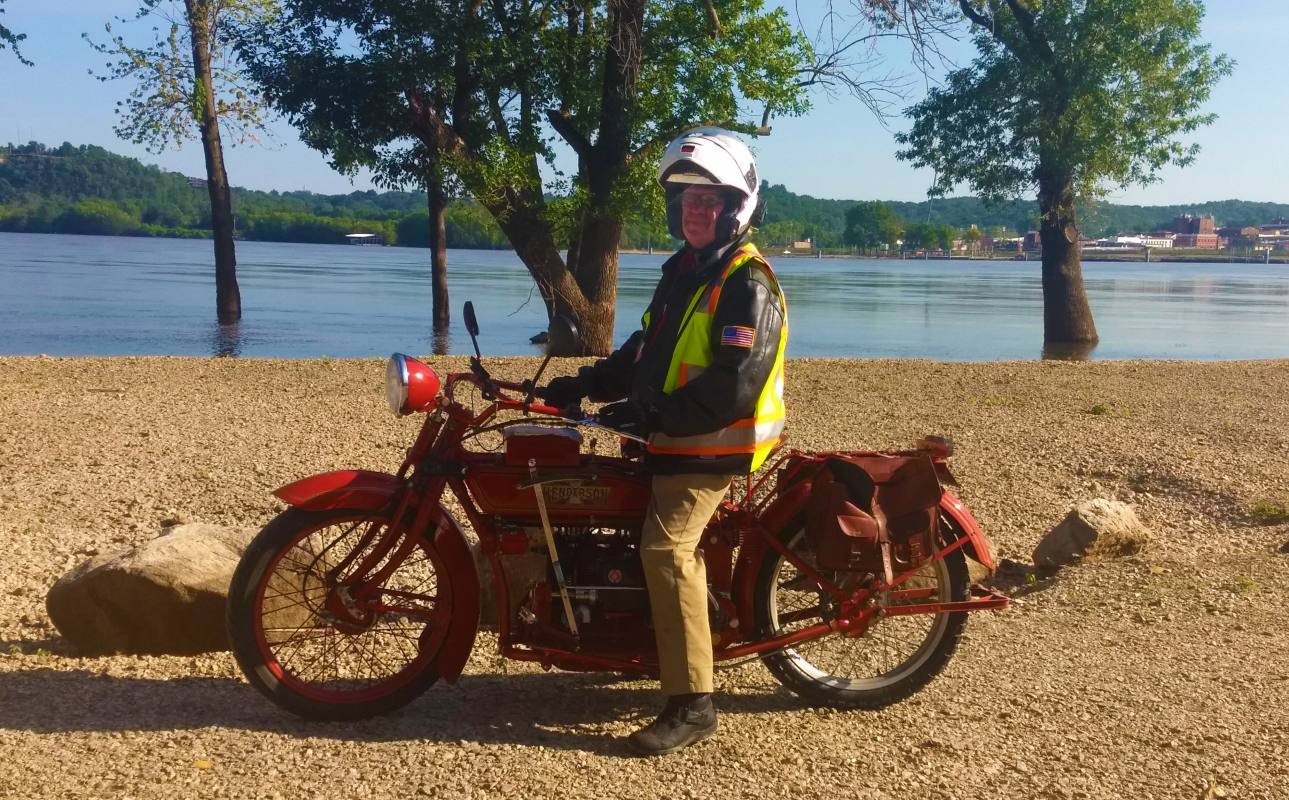 Mark Hunnibell on his 1919 Henderson Four on the east bank of the Mississippi River (Hannibal, Missouri, visible on the other side)
Mark Hunnibell on his 1919 Henderson Four on the east bank of the Mississippi River (Hannibal, Missouri, visible on the other side)
Upon our arrival in Hannibal after a quick photo shoot across the Big Muddy, it was clear that even the use of stainless steel had mostly succumbed to the intense exhaust heat. At that point, Loring decided to install the original cover plate, which had to be, by its original use, up to the task. Once installed, it was no longer an issue.
The next day, our destination was Kansas City, Missouri. While we had gone a few miles down dirt roads the previous day, as documented by CK on his journey a hundred years ago. After a scant few miles, we proceeded to trek through mostly two lane rural roads that took us through very small towns and farms, which at first were paved. After a while, the route turned to dirt roads, which threw plumes of dust that informed the farm and field inhabitants for miles around that we were coming, and have gone. Remember that we have a old bike with a total loss oil system and exposed valve tappets, combined with nothing more than an unfiltered carburetor sucking in tiny grains of dust. After about ten miles or so, Willie and I wondered if Mark had really intended to keep going, given the potential damage to the vaunted Henderson Four. As each mile proceeded, we began to wonder what Loring was thinking about this particular challenge to the ancient bike’s motor. Finally, after roughly forty miles or so, Marked turned off and began heading down a main tarred road where we were to gas up. As we pulled into a local post office parking lot (closed, as it was Sunday) we could see Loring shaking his head as he pulled to a stop on his BMW. I thought Mark was in for a tongue lashing, at a minimum. Both bikes, the pickup and trailer were covered in dust – both inside the truck bed (covered) and trailer, as we opened both up for gas and oil. As Loring looked over the dusty bike, his original grimace was beginning to turn into a bit of a smile. Willie and I were both puzzled, but as he began rolling the bike under the shade of a tree to begin cleaning the bike, he pulled out his phone and dialed up, we learned later, his dad. Listening in a bit, we realized that he wanted to let his dad know what had just happened, and how well the bike held up in such adverse conditions. After completing the call, he began to boast that any other hundred year old bike would have died somewhere along the way, probably ruined for the remainder of the trip. With a sigh of relief, we collectively cleaned up the bike as best we could, and then loaded both bikes into the trailer, bound for Kansas City.
 The only part of the bike that didn’t have a layer of dust was the seat!
The only part of the bike that didn’t have a layer of dust was the seat!
As we rolled into Kansas City to check into the hotel, Willie and Loring took the truck and trailer to find a car wash and parking for the rig. The next day, my adventure was concluded when Mark asked me if I’d consider heading home from there. I agreed, and we changed my flight from Denver, and I arrived home midday on Monday.
Curious as to how the bike fared, I called Loring to find out, and he informed me that the oil from Sunday was clean, and the bike was running fine!
Mark’s adventure on two wheels ended the next day when the crankshaft broke south of Burlingame, Kansas. Mark, Loring and Willie continued on until Saturday, July 27th, when the decision to head home was made.
For the very interesting back story and more information, see Mark’s website at:
acrossamericabymotorcycle.com
The PDF of this article is also available here.
Across America by Motor-Cycle
On the 4th of July 2019, I left New York City with my 1919 Henderson on a cross-country ride in tribute to Captain C.K. Shepherd, who came to America from England, then purchased and rode a fully-loaded 1919 Henderson from New York to San Francisco. In 1922, Shepherd would later author a book about his trip, Across America by Motor-Cycle. I had mapped out C.K.’s 1919 route and planned to ride my “Red One” all the way to San Francisco (the “Red One” moniker is a nod to my Henderson’s original one-a-kind “fire engine red” color that Yankee John Piece dutifully recreated for me). But my cross-country journey was interrupted a mile and a half south of Burlingame, Kansas, when the flange connecting the crankshaft to the flywheel sheered, ending the Red One’s driving days until I could get the crankshaft replaced months later. We trailered the bike into Burlingame and continued “on tour” as far west as the Grand Canyon, taking in the landscape, meeting people, and taking photos along the way.
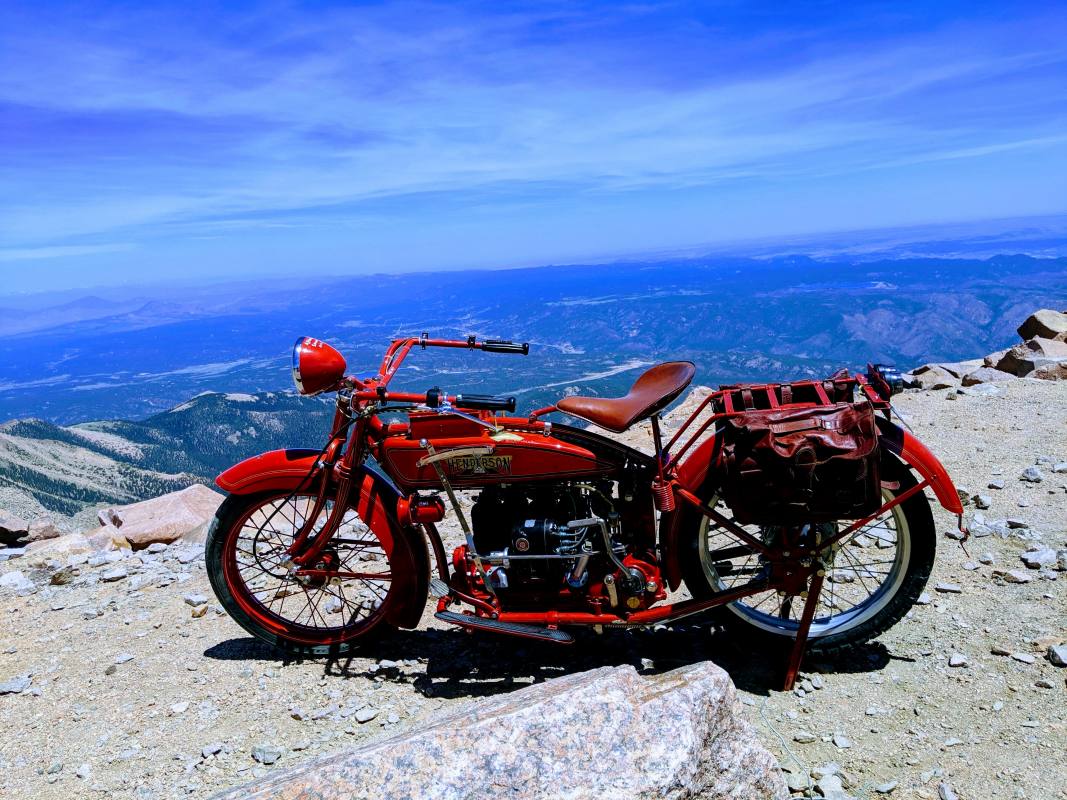 Pikes Peak: C.K. wrote about wanting to ride up Pikes Peak, but he didn’t attempt it. We toted the Red One to the top in the bed of the support truck on a road that would have been more than a challenge for me if I had even tried to ride it.
Pikes Peak: C.K. wrote about wanting to ride up Pikes Peak, but he didn’t attempt it. We toted the Red One to the top in the bed of the support truck on a road that would have been more than a challenge for me if I had even tried to ride it.
Eight months later, the Red One is once again operational and eager to be ridden, and it now seems the adventure will continue. More on that later.
Even though Chatter editor Greg Ravizza gave his personal perspective of this ride in the Fall 2019 edition of the Chatter (pages 11-14), I thought it would be helpful to give fellow Yankee members my own insight on this adventure (I am still a member of the Yankee Chapter and plan to come and speak at the Yankee National Meet in Terryville this year, conditions permitting).
This 1919 Henderson is the first motorcycle I ever owned. My father gave it to me back in 1978 as a basket case in pieces. It would be 40 years before the Red One was once again roadworthy. My brief foray into the motorcycling world began with a yellow Honda Express 50cc “no ped” scooter that I bought new in 1979. That was how I got my “Motorcycle” endorsement on my Driver’s License, but I sold the Honda Express within a year after having a near-fatal accident. Fast forward many years, as the Red One neared its completion and I began serious planning to ride it across the country, friends encouraged me to get some training and buy a “modern” bike to ride for practice to gain experience. Even though I already had a motorcycle license, I took the Ohio Basic Riding Skills (BRS) course and then bought a 1973 Honda CB 350 Four, which is a bit of a collector’s item in its own right. But, with four carburetors, the 350F is also pretty finicky, so I didn’t ride as many miles on it as I wanted. In the end, it is fair to say that the 1,300 miles I rode the Red One last year represent probably five times the total number of miles I had previously ridden a motorcycle in my entire life. I mention all this as a background to explain why my departure from New York City didn’t exactly go according to plan.
Eight years earlier, I recall the evening before the Yankee Chapter Meet opened in 2011. Yankees Darryl Cutter, Rich Correia, and I were enjoying some “refreshments” out at the gate when I mentioned the problems I had in getting my engine running. I had it restored by a supposed expert in Canada, but it would not turn over. Armed with the knowledge that I planned a long trip on the bike, Darryl thought that it would be worth my time and money to have Mark Hill look at it. Mark owned 4th Coast Fours in Waddington, New York, and was – even then – emerging as the premiere Henderson shop. In fact, I had met Mark Hill four years earlier at the Rhinebeck meet. He was, in some respects, just starting out. However, 20/20 hindsight allows me to clearly see I should have pulled my engine out of Canada in 2008 and brought it to Mark Hill. However, beginning in 2011 and ending in 2018, Mark worked on my engine. He first assessed it would be about 40 hours of work to get it going. However, he found a cascading series of major problems resulting from defective workmanship. I was determined to restore as much of the original engine as I could, even knowing the time and cost of doing that was much higher than if I would have started with an engine that had not been so fundamentally damaged. By the end of those seven years, Mark, his son Loring, and others in his shop had spent hundreds of hours of TLC to get the Red One all back together again. Mark Hill was so committed to the success of my 2019 tribute ride that he dispatched his son Loring (who had just completed a full miles ride of the 2018 Motorcycle Cannonball as the youngest rider ever) to accompany me on my 2019 ride as long as I needed him, as safety rider and mechanic.
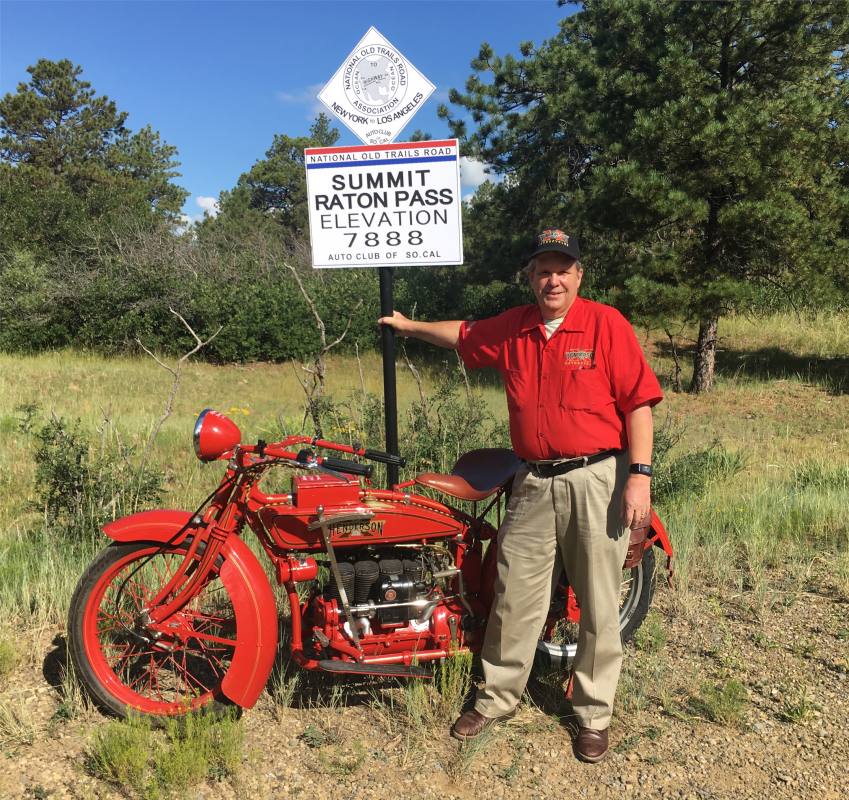 Raton Pass: The old Raton Pass Road was closed back in the 1950s and the summit near the border is now on private property. The owner graciously escorted us to the top to take in the view at the New Mexico border about which C.K. waxed so poetically.
Raton Pass: The old Raton Pass Road was closed back in the 1950s and the summit near the border is now on private property. The owner graciously escorted us to the top to take in the view at the New Mexico border about which C.K. waxed so poetically.
In addition to a dedicated safety rider and mechanic, I needed someone to drive my truck and trailer for support. Mark Hill had originally envisioned having one of his employees performing that function, but a short-notice departure of a machinist made it impossible to allow anyone else to go from Mark’s shop. My schedule was such that I would be on the road for six weeks, and I thought it would be difficult to find a new support driver to take me all the way, which is why I cast a wide net to try to “stitch together” a series of legs for support. Willie Fernandez, a local businessman and specialized automotive entrepreneur, opened up his schedule to help me as a driver from New York City to Ohio, but he did not think he would be able to go all the way to San Francisco. As Greg Ravizza noted in his Fall 2019 article, Greg joined me in Ohio to assist during the second segment of the trip, where we planned for him to be relieved in Colorado by another Yankee member, Debbie Faucher (Dana Faucher’s wife). Just as we arrived for a planned two-day stop in Ohio, Willie made arrangements to stay on the trip for the duration, but Greg was already on the way to Ohio.
So Willie drove (and Greg would ride) in the support truck to Colorado. In exchange for his commitment, I agreed to Willie’s “demand” that he be allowed to tow the trailer with his own more-capable diesel double-cab pickup truck rather than my smaller truck. By the time we got to Kansas City, it was pretty apparent that Greg’s gracious offer to assist was no longer necessary. Besides getting Greg home from there, I also had to “turn off” all the previously-laid plans and accommodations for Debbie Faucher. My very earnest thanks to both Yankees for their generous offers to assist!
As we planned to leave New York City on July 4th, 2019, I had less than 250 miles on the bike. Faced with imminent launch, and having previously driven and even filmed the entire planned route (from 4-wheeled vehicles), I suddenly had concerns about my ability to ride it out of New York City without killing myself. Loring Hill, a highly skilled rider but who had never been into New York City in his life, stepped up. After reviewing the planned route and enlisting the help of a handful of local bikers, Loring fired up the Red One at the Triumph Brooklyn motorcycle dealer. He then proceeded to drive the Red One right over the Williamsburg Bridge, then crosstown in the stop-and-go traffic of NYC summer heat, into the Holland Tunnel, and on to our planned stop of New Jersey. I can only imagine the emotions that Loring experienced on that trip (which was only five miles, but must have seemed like ten times that).
Proper discussion of that five mile ride would be an entire article in itself, but I think it is fair to say it might have been a life changing event for Loring! I think I aged a couple years just watching how each second unfolded, most of the time in shock it was all really happening.
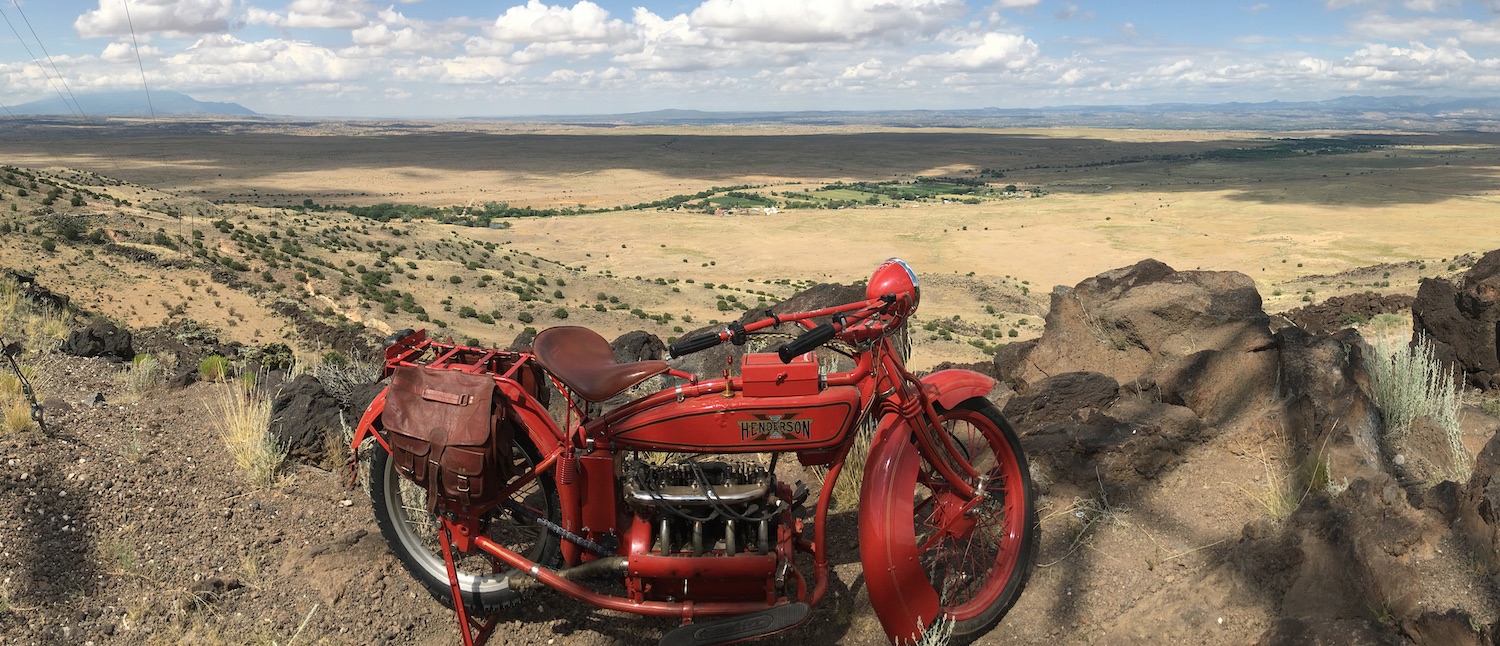 La Bajada Hill: The old road down La Bajada Hill is closed now, but was once part of Route 66! The road to the top of the escarpment is no cake walk either. From the edge, we could peer down and see the pueblo below, and even the small cemetery C.K. wrote about.
La Bajada Hill: The old road down La Bajada Hill is closed now, but was once part of Route 66! The road to the top of the escarpment is no cake walk either. From the edge, we could peer down and see the pueblo below, and even the small cemetery C.K. wrote about.
The next morning I got on the Red One and, with a few pragmatic logistical exceptions, I drove it from New Jersey to Kansas. On my first day of riding, something else dawned on me. It was probably no surprise to Mark or Loring Hill, but I suddenly realized that Loring wasn’t along just to be a safety escort and mechanic. Loring was my “Field Instructor” for “Henderson 101,” a crash course in riding, surviving, and maintenance; a condensed curriculum of lived experiences that I was now receiving through a firehose. A very large firehose!
Compounding matters, which I suspect Loring quickly realized, he wasn’t going to just be the instructor for “Henderson 101,” but would also help me catch up on the basic “Motorcycling 101” class that I had never attended. At the end of each day, I was tired. I wanted to help with servicing the bike, but Loring had me on another task. Although I had mapped the entire route out in Google Maps, Loring wanted “turn-by-turn instructions” (like they use on the Cannonball) printed and taped to our gas tanks. At the end of each day, Loring always asked, “How many miles tomorrow?” It was a question to which I often knew the general answer, but I also knew what he was really asking for was the printed turn-by-turn instructions for the next day. Thus, upon each arrival, I had to hurry to my room and make new trip sheets. The result was that it took me until Kansas City before I had more than tomorrow’s riding converted to turn-by-turn instructions. Sadly, we only did one complete leg after Kansas City, so all that “new map” work ended up being a largely unused exercise.
Generally, over the 1,300 miles, I received increasingly positive feedback on my riding (though it takes a special person to receive input like, “it was not as bad as yesterday,” as positive feedback). The glaring exception occurred in Missouri where my planned – but not pre-briefed – route was over a series of gravel roads, a total of 21 miles of gravel! When I scouted this route in 2018 (in a car) these roads were in good condition, dirt over gravel base. But when we got there in July 2019, it seems they had just “re-graveled” the roads with about two inches of ¾-inch round and crushed rock. Although I had ridden a mile on a dirt road earlier, the riding here was much more difficult, but I never went down. Even Loring, who was shadowing me on his BMW 1100, found sections challenging. Greg Ravizza was in the support truck watching the horror of it all, and his article provides a good review of what he saw.
But Greg wasn’t there when we got to the first stop after riding the “gravel pits” and Loring ushered me (a nice term for what seemed like being dragged by my ear) out behind the trailer (woodshed) and let me have it. He was really pissed off. He didn’t like surprises and told me that, if we ended up with any more unbriefed off-road travel like that, he was going home. Since I knew the next “off-road” sections would not be until southwest Colorado and that I had better “off-road equipped” safety riders joining me for those segments, I quietly tended to my bruised ego and figured that I would have time to work this out. But, yeah, Loring was pissed. I didn’t see him make the phone call to his father that Greg reported, but by the end of that day or the next, he had calmed down and characterized it as “a happy accident.” He said to me, “I have never seen or heard of anyone driving a hundred-year-old Henderson that many miles off road. The fact you’re here to talk about it is a testament to the work we did on your bike.” I sensed recovery; my ear was healing. There was genuine pride in his voice. I replied, “And I am sure that success was not the least bit the result of the 62-year-old novice hanging on for dear life most of the way. And besides, C.K. Shepherd did his ride 95% off road!” Lucky for me, Loring didn’t snap back with what I knew to be an essential truth: C.K. was 30 years younger, needed to have the engine completely rebuilt three times, and his bike was still a wreck when he got to San Francisco. In this case, successful outcome was due to solid preparation, plain and simple.
A day or so afterwards, I recall a conversation with Loring and Willie during dinner where I felt that I had accurately summarized the state of affairs, which was that I felt Loring was quick to anger when he perceived an apparent nonchalance by me over the events. I told him, “Loring, I think I’ve finally figured out how to put this in perspective. With all your personal sweat, tears, and time invested into getting this bike back together, you have an emotional attachment to this motorcycle. She’s like your daughter and you get very worried and upset when you see some knucklehead like me putting her in risky situations. I get that.” I think he must have agreed because, at least in part because, from then on, it was all good. There would be no further meetings behind the woodshed and my ear would eventually heal without scarring.
As I said, after reaching Burlingame, Kansas, the crankshaft ended its relationship with the transmission and the ride was over. We continued “on tour” including toting the Red One to the top of Pikes Peak, the top the old Raton Pass Road, La Bajada Hill, the Petrified Forest, Flagstaff, and the Grand Canyon, where we were met by C.K.’s only son with his wife.
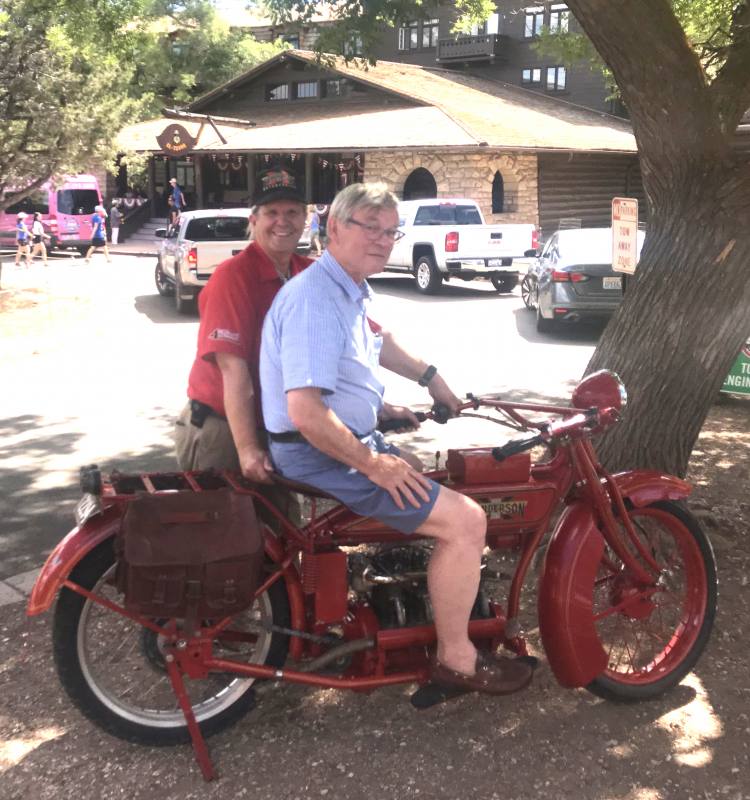 Grand Canyon: C.K.’s son, Charles Shaw, met me at the Grand Canyon and we all stayed at the El Tovar hotel that C.K. described as “all but toppling over the edge.” We parked the Red One out front and turned many heads with the last public appearance.
Grand Canyon: C.K.’s son, Charles Shaw, met me at the Grand Canyon and we all stayed at the El Tovar hotel that C.K. described as “all but toppling over the edge.” We parked the Red One out front and turned many heads with the last public appearance.
Since then, Mark Hill tore the engine down and, except for the crankshaft, he was pleased to see no other major internal injuries. I had Mark install a brand-new state-of-the-art fully counterbalanced crankshaft and have been waiting for the winter to be over before getting the Red One back on the road. My web site has a video of Loring doing a few donuts in the snow on the Red One after the engine was rebuilt.
If you have not been to the web site, there is a huge amount of information about this “little project” and you can also sign up for updates. I have produced an audiobook of C.K.’s original 1922 book, as well as a fully-annotated centennial paperback edition of the 1922 classic with almost a thousand new notes, photos, and figures. The links are all on the web site.
If national and local emergency rules will allow, I am now planning to restart the journey in September this year, as a “ride and tour” where I will ride the Red One in and around most of the key places from Burlingame, Kansas, to San Francisco. Back in 2018, I applied to ride in the 2020 Motorcycle Cannonball but have not been approved, so my plans follow the “Get Busy Living” model that informs me I cannot wait for others. I also hope that the national emergency will allow me to bring the Red One to the Yankee meet at Terryville this year and will be happy to see you all again. Maybe she’ll even feel up to a little “Mystery Ride.”
www.acrossamericabymotorcycle.com
mark@acrossamericabymotorcycle.com


